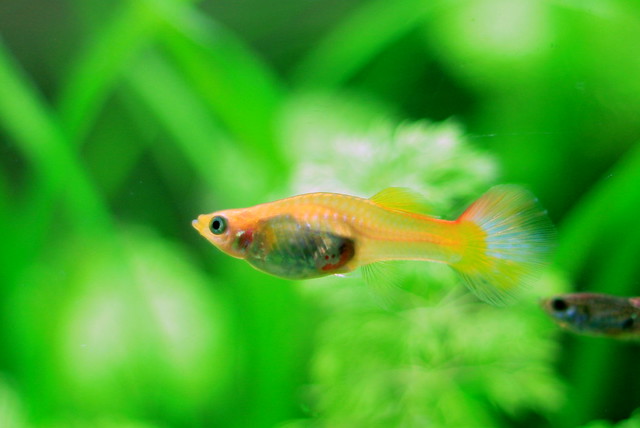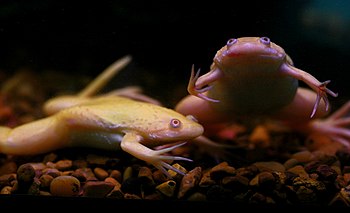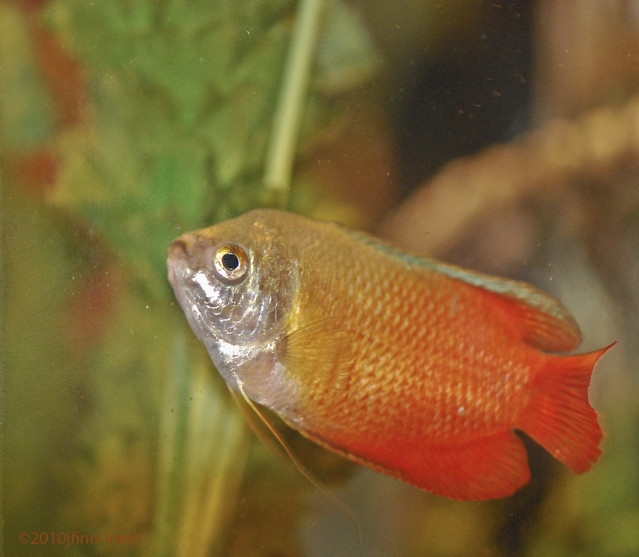For Discus fish, there is 2 consideration in tanks - tank depth and volume. Because of their size and swimming habits, a minimum of 18" is needed for tank depth, the deeper the better. Regarding volume, a good rule of thumb is that each adult discus will need 10 gallons of water. Larger tanks will also give more stable water conditions, and take into account other considerations the minimum size for a discus show tank should be no less than 55 gallons.
 |
| Photo by puliarf |
It is also advisable to use a rectangular tank. Not only are they cheaper, but are more efficient, because they maximize surface area. Surface area is the most important factor in buying a tank. Why? Because it is only at the surface of the tank that gas exchange occurs. (Oxygen in, Carbon dioxide out.) Assuming you have a seventy-five-gallon show tank, and its biological filter is working as required, up to twenty young fish 3 inches in size, or 6 or 8 fully adult discus can comfortably inhabit the tank. An outside filter may be added to large tanks to increase basic aeration and biological filtration needs.
Keep in mind that when young discus fish are small, they grow fast and become quite large in a short period of time if fed well and water quality is maintained. If your tank is too small they will not be happy and it will quickly stunt their growth. Juvenile discus should not be kept in overly large tanks. Being a social fish, Discus tend to become very skittish in large tanks. In our hatchery, we place 6 Discus up to 1.5" in a 29-gallon tank. They will be moved to larger tanks when they get to 2.5", and show possible signs of "pairing off". Always try to buy the largest tank you can afford for discus fish.
If breeding Discus is a consideration, later on, tanks can be down sized to twenty gallons per pair. At our hatchery, 29-gallon rectangular glass tanks are utilized for every breeding pair.
A bare bottomed tank with at 2 ½ gallons of water per inch of fish, a couple of sponge filters and a canister filter with activated carbon in it is used to begin the process. This is maintained at 6.6 - 6.8 PH, and the temperature is set at 82 to 84 degrees F. We make 50% water changes weekly, and some breeders will go as high as 95%. Optimal results would be achieved with a 15% water change daily. Because Discus produce slime on their body, and it is shed regularly, it coats the inner surface of the tank and promotes bacterial growth. A safe bet is to wipe down every discus tank every week. There are commercial sponges and brushes available to do this chore.
Because Discus are large fish, they require clean water and proper filtration. The tank must be "cycled" and tested for nitrates/nitrites before placement of Discus in the tank. Our policy is to use fish such as some of the more common cichlids to "cycle" the tank. A good rule of thumb here is to wait at least 4 weeks before attempting to place Discus with the "cycling" fish. If you are active in the aquarist community, a friend might possibly loan you some "cycling fish" to begin your project, and the "cycles" can be returned to their owner upon completion of the cycle.
Discus prefers soft water, due to the constant rainfall and run-off in their natural habitat. We are more concerned, however, with cleanliness. It is much better to have a high quality of hygiene in the tank than it is having optimal water conditions, though we strive for both. Discus will adapt to most conditions, including PH up to 7.8 and 350-ppm micro siemens of hardness, but cannot survive in constantly changing water conditions or dirty water.
Alden Smith is a published author and has been marketing on the internet for 7 years. His website, King Discus, is an active gathering place for discus breeders and lovers of discus fish. Article Directory: EzineArticles |








